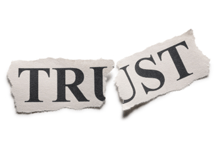Having the data isn’t the same as having the answer.
We know the public’s level of trust in the press has been falling for decades. We know it thanks to data from the Pew Research Center and Gallup polls, among other sources. The data are not in dispute.
What is up for debate, however, is why this happened. How did we get here?
NYU journalism professor Jay Rosen published a post Wednesday with five explanations for why public confidence in the press is falling. He soon added a sixth, thanks to feedback from a journalist on Twitter. Quickly summarized (go read his post), they are:
- It’s part of a trend. Other institutions such as churches, schools and the presidency are also trusted less today.
- Bad apples spoil the bunch. Loudmouths on cable news and other bad actors operating as journalists influence how the public sees us as a whole.
- Liberal bias. No explanation needed. You’ve heard this one.
- “Working the refs.” Rosen writes: “The right has learned how to manipulate journalists by never letting up on the ‘liberal bias’ charge, no matter what. This amounts to working the refs, in Eric Alterman’s phrase.”
- Problems with professionalization. The drop in trust has coincided with the increased professionalization of journalism. Is there a connection? “There was something missing or out of alignment in the ideas and ideals that mainstream journalism adopted when it began to think of itself as a profession, ” Rosen writes.
- Co-opted by power. The press has become just another part of the power structure, rather than operating as a watchdog and questioning those in power. As investigative journalist Phil Williams wrote to Rosen on Twitter, “Press more popular when viewed as standing up to power. Then it became part of power structure.”
“None of these explanations quite do it for me,” Rosen writes. “I think they all have some merit, but ‘some’ does not mean equal. I’m partial to no. 5, but I don’t think it accounts for a 28 point drop in public confidence. So that’s why I say: what would be your theory?”
I don’t want to call it a theory, and I don’t claim to have the answer, but I’d suggest we often overlook this crucial element in the discussion of trust: the human aspect.
What’s missing
A few months ago, I gave a TEDx talk with the title, “Why Failing is a Great Way to Build Trust.”
Like Rosen, I began by sharing data about declining trust in the press. I pointed to this graphic from Pew:

Looking at the data, we see since 1985 Americans see the press as less accurate, more biased and more likely to be influenced by “powerful people and organizations.”
Less accurate? That probably relates to items two, three and four on Rosen’s list.
More biased? The same numbers.
Co-opted? Rosen reasons one, five and six.
You can see how to connect the dots. That’s no accident, and it reinforces the fact that the Rosen Six are not independent of each other. They are connected.
That’s in fact the missing element: connection.
The loss of trust is, I think, strongly related to the loss of connection on a basic human level. The public lost a sense of connection to the press, to journalists and to journalism.
As recently-retired newspaper editor John Robinson wrote on his blog, people used to refer to a local newspaper as “our newspaper.” Eventually it become “the newspaper.” (He wrote about that change at Rosen’s behest; see, the connections are everywhere!)
We in the press are now an “other,” a faceless institution. Sometimes even a rogue regime.
Many things brought us to this place. The Rosen Six is a good map.
(Re)-Building connection
Fortunately, there’s also a map for how to repair and rebuild connection.
How do humans connect?
One way we build connection and trust is through vulnerability.
Researcher Brené Brown made this point in a TED talk that has since been viewed 4.3 million times. Yes, clearly people connect with her message.
Watch it:
Journalism that acts as the voice of God, that doesn’t listen, that doesn’t admit failings, that often punishes others for showing vulnerability does not build connection with the public.
We feel more connected to each other when we share our fears, failings and flaws.
“No sense in mourning something that’s history anyway,” Robinson wrote about the way things used to be between newspapers and their readers. “Newspapers — new organizations, actually – can take many steps to make people feel a sense of ownership and partnership in their journalism.”
Along with ownership and partnership, we should strive to make people feel a sense of connection to us and the work we do.
To the surprise of no one, I focused my TEDx talk on one aspect of this: how mistakes play a powerful role in building connection or severing it.
By publicizing and acknowledging our mistakes and failures, we show vulnerability.
We show our human face.
We make ourselves worthy of connection — and trust.
Join me, Jay Rosen and Roy Peter Clark for a chat today at 3 p.m. on this and related topics:







Comments